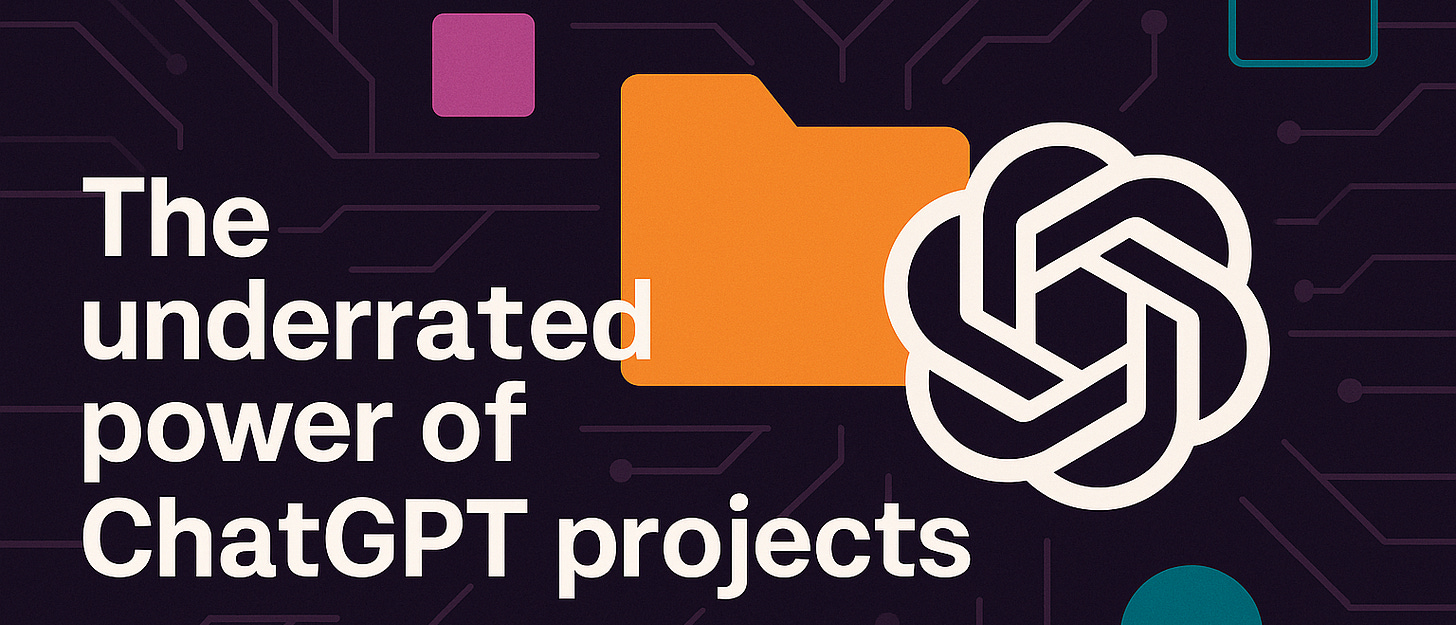The Underrated Power of ChatGPT Projects
How a simple workspace feature turned my scattered notes into a powerful, persistent knowledge hub
As my consulting business picks up, I'm encountering a familiar challenge: managing documentation and actually pulling insights from it. Client work means meetings, notes, follow-ups, emails, formal docs, and assets piling up fast. ChatGPT’s Projects feature has become an unexpected powerhouse for keeping it all connected.
Launched in December 2024 as part of OpenAI’s "Ship-mas" rollout, Projects are persistent, structured workspaces. You can group related chats, files, and custom instructions in one place. Context sticks around session after session. As The Verge put it:
“It’s basically a folder system that makes it easier to organize things you’re working on… Each ‘Project’ lets you upload files as well as instructions to tailor how ChatGPT responds.”
It’s context engineering in action—just like Philipp Schmid writes in his great piece on context engineering: the goal isn’t just crafting good prompts, but giving the AI the context it needs to do real work.
Why Projects Beat Memory
ChatGPT’s built-in memory is nice for remembering your name and a few facts. But Projects take it much further. They give you dedicated spaces with all the instructions, notes, and files for a single client or task. The Verge summed it up:
"Projects are designed to go beyond ChatGPT’s basic memory feature, allowing users to group related interactions, files, and custom instructions into structured folders."
Built-in Memory vs. Projects:
Persistence: Built-in Memory has short-term recall. Projects give you long-term, project-specific context.
Organization: Built-in Memory is minimal and automatic. Projects are fully structured and user-defined.
Best For: Built-in Memory works well for quick follow-ups. Projects shine for complex, ongoing workstreams.
How I Actually Use Projects
Each client gets a Project. I drop in notes, documents, follow-ups, research, drafts—everything. When I come back, ChatGPT knows exactly what’s happening. There’s no re-explaining. Prepping for a call? Generating a deliverable? The context is there. It feels like working with a smart partner that never forgets.
Other Tools vs. Projects
There are other options—NotebookLM, Notion AI, Copilot—but each has its own limits:
Projects vs. Other Tools:
ChatGPT Projects: Conversational + persistent context; high customization; great for project tracking and ideation.
NotebookLM: Document-driven; moderate customization; best for deep research.
Notion AI: Page/task-based context; high customization; ideal for structured documentation.
Microsoft Copilot (365): App-specific productivity context; moderate customization; best for productivity enhancement inside familiar apps.
Projects stand out because they blend natural conversation with structured, evolving context—no scattered chats or disjointed files.
Where Projects Shine
It’s not just for consulting:
Content creators: Newsletters, podcast notes, blog drafts
Entrepreneurs: Proposals, pitches, client deliverables
Students: Study guides, research notes, reading logs
Personal: Fitness plans, trip itineraries, big decisions
Why it works? Schmid’s context engineering point is spot on—LLMs thrive when they get rich, structured input, not just clever one-liners.
A Few Habits That Help
Clear names: “Client – Q3 Strategy” beats “Stuff to Remember”
Keep context fresh: Update notes & instructions as you go
Organize content logically: Use clear headings or recurring threads for Goals, Notes, and Tasks so it’s easy to skim later
Add instructions: Tweak tone or style for each workspace
Easier than search: You can search old chats—but organized Projects save so much time
Final Thoughts
Projects changed the way I use ChatGPT. They turned my scattered ideas into a persistent, evolving second brain. If you haven’t tried them, do. You’ll see how underrated they really are. One suggestion I do have for the OpenAI team: it would be amazing to integrate Projects with Google Drive. Imagine being able to set a Drive folder as the context for a Project—no more uploading the same docs twice or losing version control. It would make context engineering even smoother for real-world workflows.
Your Turn
Have you used Projects yet? Are you structuring your own AI workflows differently? Drop a comment—I’d love to hear how you’re putting context engineering to work.


